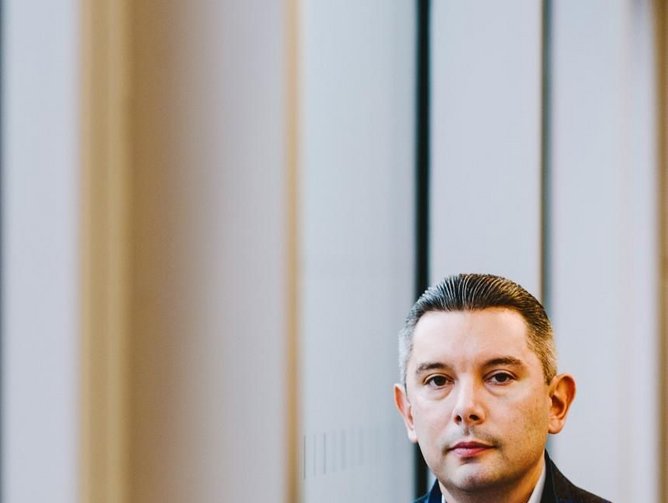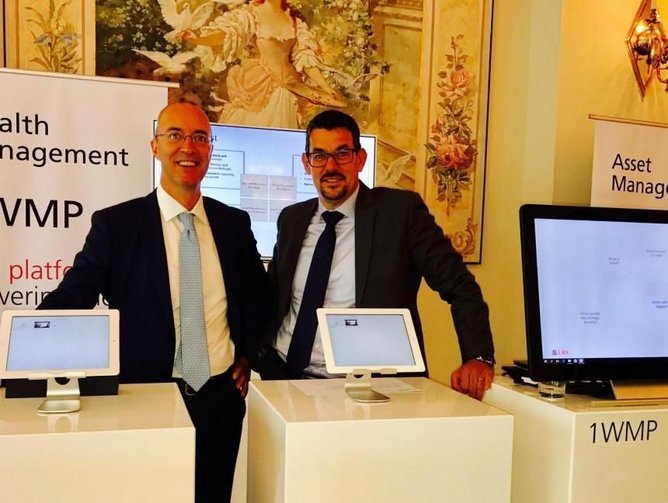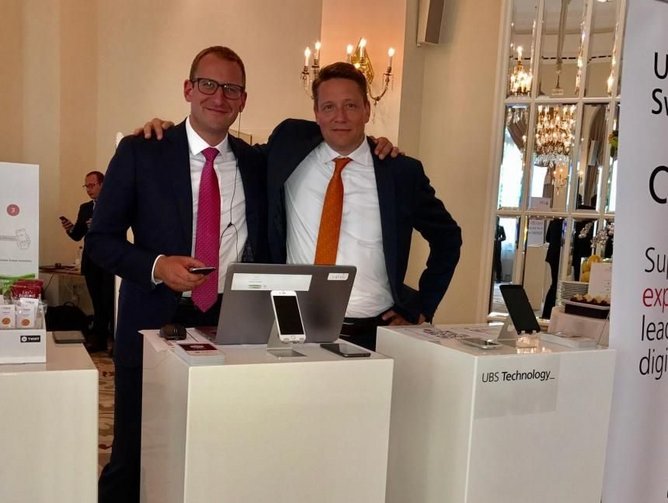Inside the technology transformation of UBS with Global Head of Technology Mike Dargan
Swiss banking giant UBS has recently opened its new office building in the heart of London. A vast groundscraper tucked under the capital’s scrupulous height restrictions, it’s an all-new 12-storey, 700,000 sq ft City landmark that appears as if hewn directly from a single giant slab of polished steel.
Its design aims to reflect the enduring solidity of the 155-year-old institution, but simultaneously broadcasts a message of technological momentum. A prominent node integrated with the City’s elaborate network of streets and alleys, the building carries the look of London’s own personal server rack.
We make our way through a vast lobby constructed much like a small mall - its outlets there to serve the needs of the building’s 5,000+ workers - and up to sumptuously appointed client meeting spaces. We’re there to talk to the man most directly responsible for delivering UBS into a singularly technological future.
The Global Head of Technology
Mike Dargan has not long celebrated his first anniversary as Global Head of Technology at UBS. He joined from Standard Chartered in October 2016 after a whirlwind recruitment process involving around 20 interviews. From headhunter call to contract it took just four weeks.
“When we want to move quickly, we can move quickly!” Dargan recalls.
But he’s used to moving quickly. Dargan earned his stripes at consultancy Oliver Wyman after graduating from Oxford, working with many of the world’s top financial institutions. He then took a position at Merrill Lynch and made managing director by the time he turned 30.
The global financial crisis of 2008 could have stalled him mid-flight, but he helped weather the storm there, playing a significant role in the integration of Merrill with Bank of America, before a judicious move to Standard Chartered in 2009. Standard Chartered had ridden the storm rather better than most, and Dargan’s trajectory remained unbowed.
But while he had risen to occupy positions of huge strategic importance, at no point thus far had Dargan entered the technology arena specifically. He did just that after four years at Standard Chartered, when offered the role of CIO for Financial Markets.
“I was asked to step in to improve the relationship between the business and technology and operations, and take things in a different way,” he says.
“My background, through most of my career, was not technology. It wasn't something I was thinking about doing. But I fundamentally believe the underlying nature of banking is technology and that the world would move to tech and to the automation of operations, and so it intrigued me. I decided to do it.”
And he hasn’t looked back since. After initially inheriting a team of 2,500 and a $250mn budget, by the time he left to join UBS three years later he was CIO of corporate and institutional banking with a $1bn budget and accountability for 11,000 staff.
Now, at UBS as Global Head of Technology, he manages a budget of 10% of our revenues and looks after a total more than 20,000-strong tech workforce. It’s a team loaded with talent and spread around the globe, tasked with enabling UBS and its core business areas – wealth management, retail banking, investment banking and asset management - to seize the opportunities of a rapidly digitising world.
Cultural Revolution
“It was an intense first year, shall we say,” says Dargan. He says that while he found a committed, talented and stable organisation, it was one burdened by many of the usual issues of legacy infrastructure, layers of process and a patchwork of applications. He set about changing all that, and as he describes to us the approach he took, a consistent theme quickly emerges: Dargan’s deep commitment to a people-first tech philosophy.
There’s a difference between ‘management’ and ‘motivation’, he says, so among of the first of his actions was for he and his team to hit the road.
A lot.
“I think there's a change in what people are looking for in terms of leadership. I think people are craving a more personal style than we have in larger or more regulated institutions. So my management team and I do whatwe call coffee corners. Coffee corners have 20, 30, 40, 50 people in them,” he says.
The small, intimate coffee corners reflect his belief that being as open, accessible and transparent as possible is one of his greatest responsibilities. It’s a personal and very direct means of communicating the honest views of management and to involve every member of a huge, diverse team in what’s happening. Dargan left his Zurich base to conduct 62 coffee corners and team events in his first year – more than one per week.
“I've done Singapore three times, Hong Kong three times, New York four, London four or five, India two or three, Poland two or three, different parts of Switzerland… because it's the only way.”
He also regularly blogs for internal consumption, covering topics as varied as techniques for ruthless prioritisation and achieving a sustainable work-life balance. It’s a dedication to communication aimed squarely at motivating his organisation around its purpose at the heart of the bank. He says it’s about building a collaborative culture rooted in empowerment, business alignment, customer centricity and strong technical excellence.
“For me, there's a big piece around what that intersection is between the business and technology. How do you bring those two sides together as much as possible? Only when you're working that intersection of business and technology do you bring things together. There's a connectivity that we're trying to build up.”
Underpinning Dargan’s culture shift as well is a desire to create a work environment fit for the needs of a modern workforce. UBS isn’t just competing with other banks for tech talent, but a galaxy of start-ups, Facebook, Google, and the like. On that basis he says enabling a highly-regulated environment like a bank to shrug off some of its more prescriptive work habits is key to creating a desirable place to work, and to help foster collaboration and liberate effective decision making.
Hugely reducing the burden of inflexible KPIs was one step – it’s down from >100 to just 20 for the technology team. Or, at its most basic level, down to just two: 1) Identify and deliver desired outcomes; 2) do it on budget.
“If you are definitely hitting your budget, you are doing it within the parameters of risk, you are defining your outcomes in partnership with the business… If those were your only two metrics and you understand, internalise, interpret them in the right way, that enables you to run your business.”
A diverse workforce is an empowered one, too, stresses Dargan. His logic is straight forward - if the human population is 50-50 male-female, then a technology organisation with too few females probably doesn’t have the right level of talent. As if timed to make the point, a few days after we speak Dargan is joining colleagues at base in Switzerland for a week-long series of events aimed at furthering the cause of gender diversity in tech. UBS also marked International Day of the Girl recently, and has an ongoing Women in Technology initiative.
“I look at the world through many lenses. One is that I'm a father to two young daughters. Another is my job and what that means. There's been a big piece for us in terms of what diversity means.”
A five-point plan
Dargan doesn’t need to digitise banking. As he points out, banking has been digital for decades.
“If you distil banking down to its essence, banking is nothing other than the digital transportation of data. But we're in the process now, I think, of waking up to how we need to re-digitalize banking. I think there's an increasing realisation that everything will be underpinned by technology.
“UBS actually has a very strong infrastructure; its stability is very strong. The piece that we wanted to focus on was how we reconnect the organisation with the business in a much stronger way. How do we focus on what people do, the type of people we have, how we interact with our vendors, and the underlying outcome-focused culture we wanted to develop.”
To tackle that challenge, Dargan has circled the technology team around five operational pillars of digital transformation at UBS, coffee corner by coffee corner.
First has been defining the core vision – the ultimate objective of UBS’ technology journey: “Not just for the technology organisation itself, but what does technology mean at UBS? How do we keep UBS competitive as the world increasingly digitises?”
Second is harmonising the ‘how’. Dargan has placed a premium on the development of clear, business-aligned technical roadmaps. The aim is to end a pattern so ubiquitous in large organisations of siloed operations where applications and services tend to be developed in a vacuum, their outputs inconsistent and poorly integrated. “What do we do, how do people develop technology, architecture? So we have an efficiency strategy of standardised road maps for each area.”
The third pillar has seen the remapping of the technology organisation structure itself, from top to bottom, which in turn relates to a fourth pillar dedicated to defining and simplifying as far as possible the operational processes, KPIs and financials against which the organisation’s performance is judged.
Finally, the fifth pillar articulates workforce and vendor strategy. Or, as Dargan puts it, “how we actually get stuff done”. Simplification and efficiency is the key: “I inherited a workforce that was much more vendor than permanent staff. So we made some changes and continue to make changes on that, as well as vendors. We were operating with too many vendors. We've exited tens so far and we have more to do by the end of the year..” Crucially, they need their vendors and partners to meet not only technical requirements but also that they share similar values and support their cultural evolution.
Innovation Outcomes
While Dargan’s five vision-orientated operational pillars will power the engine of continuous improvement for UBS’s technology group, another five focus points help him communicate what the outcomes of all that effort will actually look like. They are his A,B,C,D, and E of innovation.
He explains: “I think the simpler you make things, the better it is. So the ABCDE is, for me, the simplest way to think of what are the five things we do.”
A is for Automation:
“So automation, how do you automate processes or manual work to get the best possible outcome. So that may be AI, it may be robotics, it may be simple software, it may be unstructured [data], and so on. But: automation.”
B is for (un)Bundling:
“Unbundling is really two aspects. How do you move to an open API type environment and/or blockchain? Embracing those sorts of technologies to drive things in a different way.”
C is for Cloud:
“What do I see as the biggest change we all see? I think it is banks embracing cloud as one of the core areas of what we do. Two years from now I’d expect 75 percent of our apps to be cloud-enabled.”
D is for Data:
“Banking is data. As a client you identify a number, generate a transaction. That transaction is data - it goes to an execution platform, a pricing, a trade, a risk, a settlement, a confirmation. And that routes back to you as an identified number and you have done a trade. Banking is essentially just the transportation of data.”
E is for Experience:
“User experience or client experience. I think more and more we need to think back from the client journey and how we design in that way, and I don't think historically we have done. Do I think that people are going to entrust an AI bot to give them advice about their wealth and their mortgage and their children and their schooling for example? Not really. But I do think the greater data, the greater analytics, the more technology-enabled the client-relationship management, all can serve to better help people with what they want to do with banking.”
The future
Twelve months in, Dargan has helped UBS’s vast technology team find a sharp focus to its purpose as the essential enabler of the company’s future. It’s a period that’s already seen the roll-out begin of a $1bn unified tech platform for UBS’s flagship wealth management business, called the One Wealth Management Platform. It’s succeeded in rationalising a historically fragmented infrastructure globally into one centralised system. And work continues apace on what Dargan calls the “Client Experience 20/20” (or CX2020), UBS's strategy for constant improvement in client experience up to 2020 and beyond focusing on the digitalization of end-to-end processes in our personal and corporate banking in Switzerland..
He’s simplified the core mission, the process by which it will be accomplished and measured, and set about facilitating 24,000 talented people to be first-rate partners to the business around the globe.
The pace won’t slacken over the next 12 months and beyond, however. He’s quick to admit that, as with many large institutions racing to embrace a digital destiny, an existing, highly competent workforce will need to be supplemented by new skills.
“Do we have enough skills of the right type or the right sort? No. So this is a great plug that we are out there hiring engineers and other deeply technical people and we want them to come to UBS because it's a great place to work. Do we want to supplement what we have with skills as we move toward our ABCDE? Yes, we have already started down that path” he says.
A continuous stretch towards true agility is also a goal. Agile is a methodology that demands appropriate development toolchains, automated testing, and so on, but systems mean little without the right partnership mindset, insists Dargan. True agility, and the ability to quickly provide transformative technology to the whole business, will ultimately depend on developing a collaborative organisational culture empowered to deliver it.
With every cup of coffee and with every blog post, it's clear that maintain the human side of technology is a mission he's taking quite personally.









